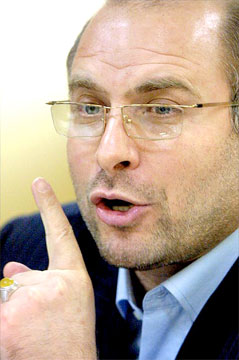
Sometimes news takes time to get out of Iran – particularly when it comes to internal strife in the upper political echelons. But eventually, major clashes leak out. This week the news emerged that Mohammad Bagher Ghalibaf, the mayor of Tehran and Ahmadinejad’s main rival in the Osulgarayn (Principalist) movement, resigned from his post just before the end of the previous Persian calendar year – approximately March 18 or 19.
A number of days later, he was reinstated to his job after his resignation was rejected by senior officials, most likely the supreme Leader of Iran, Ayatollah Khamenei.
The news was first published in the Tehran-based Jahan News, which is affiliated with Iran’s Ministry of Information and Security, known by its Farsi acronym as VAVAK.
According to the report, the main reason for Ghalibaf’s resignation was the termination of supply of cement, primary materials, and tools required by the Tehran municipality for its subway project for the city of Tehran. This follows another controversial decision by the government to cut subsidized gasoline provided to the municipality’s cars. This decision forced the organization to purchase gas at market prices – six or seven times the price. These decisions first caused a number of senior municipality managers to resign, followed by the mayor himself.
The very fact that he took a step as extreme as resigning from his post is an indication of the intensity of the rivalry between him and Ahmadinejad. As mayor of Tehran, Ghalibaf depends on the national government, and Ministry of Interior in particular, to supply him with material and subsidized goods for city projects. He can’t just simply go out and buy them himself.
According to government regulations, the Ministry of Interior must approve every purchase and, in many cases, supply the goods as well as the funds. As president, Ahmadinejad wields power over the Ministry of Interior and other ministries that deal with Tehran Municipality. With such power, he can make life as easy and as difficult for Ghalibaf as he chooses.
Since 2005, Ahmadinejad has decided to do the latter.
Numerous projects have been delayed. A notable one was the supply of buses to the municipality for its Bus Rapid Transit (BRT) scheme, which Ghalibaf has been championing as a solution to Tehran’s traffic problems since late 2005. This notwithstanding the $600 million of approved funds, which the government refused to release to the municipality. Recently, Ghalibaf hit back, removing posters celebrating the 100th anniversary of the country’s oil industry, which showed Ahmadinejad standing in front of a refinery.
Ahmadinejad’s perception of Ghalibaf as a threat is quite accurate. There are many within the Iranian conservative movement who are concerned about the damage Ahmadinejad and his disastrous economic policies have caused their movement. They see Ghalibaf and his support for more moderate foreign and economic policies as hope for redemption.
There is also Ghalibaf’s military record as well, far more distinguished than that of Ahmadinejad. Ghalibaf was a senior commander in the Revolutionary Guards, and unlike Ahmadinejad, he has lost family (his brother) in war.
The resignation of Khatami also seems to have boosted Ghalibaf’s position. Some of Khatami’s supporters now back Mousavi (Khatami’s replacement). According to Shafaf News from Tehran, more than half of Khatami’s supporters now back Ghalibaf. One of the main reasons is thought to be because they see Ghalibaf as a good prospect, due to his good relations with the Revolutionary Guards and Khamenei himself.
Judging by Khatami’s resignation and Ghalibaf’s temporary resignation, the level of discord within the Iranian government is reaching a new level, and Ayatollah Khamenei knows this. This is why Khatami was most probably advised not to run: because the animosity which he creates between the conservatives would have created more division and infighting.
Ghalibaf’s resignation would have been another embarrassing blow, as he could have become the second senior official (after Larijani) to resign because of Ahmadinejad – hence the successful pressure on him to reverse his decision.
These developments show that President Obama’s policy of refusing to negotiate with Iran until after the presidential elections is on target. Once the elections are over and the dust settles, Washington will be in a much better position to deal with Tehran. Waiting until then will not be an easy decision, especially economically. According to a recent study by the CATO Institute, oil prices are set to rise again, which could force Americans to pay $3 or $4 for their gasoline at the pump.
This will provide Iran’s political hierarchy with more leverage at the negotiations.
However, negotiating before the elections could bolster Ahmadinejad and weaken the people of Iran, as well as politicians such as Ghalibaf who oppose the president. This must be avoided.
Hopefully, the political divisions and the internal enemies Ahmadinejad has created may do a much better job of bringing him down than the U.S. or Israel ever could.
Meir Javedanfar is an Iranian – Israeli Middle East Analyst. He runs the Middle East Economic and Political Analysis Company (meepas). He recently started the Middle East Analyst blog (www.middleeastanalyst.com). This article originally appeared in PJM Media.






